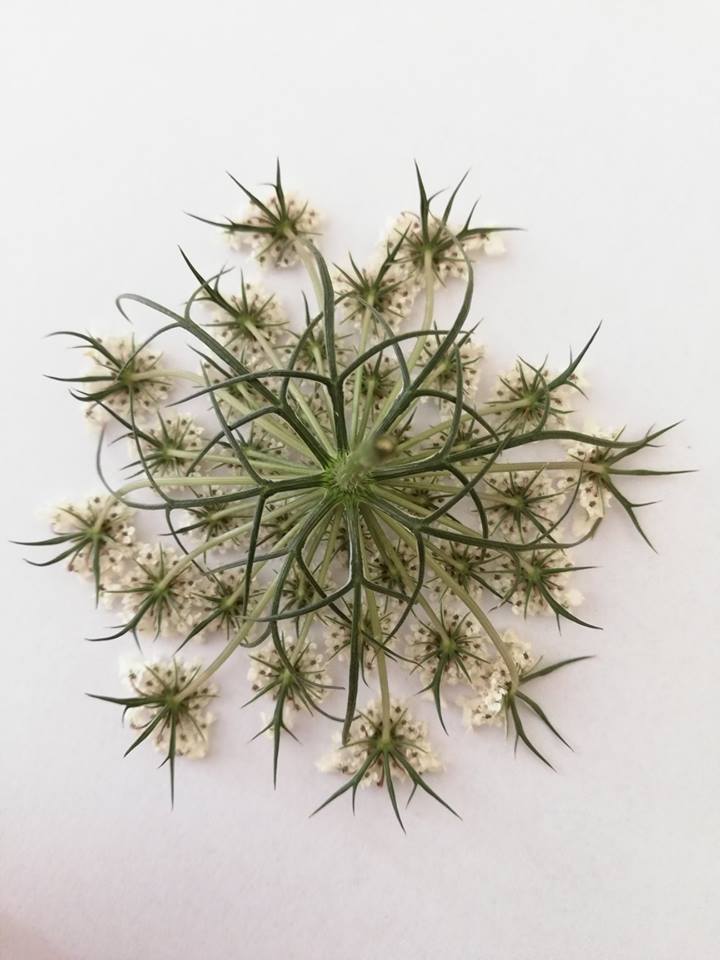
Wild carrot (Daucus carota L.) is native to temperate climate zones of Europe and South-West Asia, but now present also in North America and Australia. Its flower can be seen almost everywhere during the summer (it’s in flower from April to October), especially in the meadows, along the roadsides, in the uncultivated fields and more generally in arid environments, from the sea level up to abt. 1400 meters above sea level [Acta].
The flower (or, more correctly, the inflorescence), seen from afar, seems almost an insignificant one but, on a closer look, it reveals a quite astonishing complexity, looking like a lace (from which its other common name “Queen Anne’s Lace”). When the plant sets seeds, the umbrel closes upon itself assuming the form of a nest, in which a lot of insects and bugs find shelter.
The whole plant is edible: the root can be eaten like a regular carrot, even if its taste is stronger and it contains a fibrous and hard inedible core that grows and hardens as the plant ages; the aromatic flowers can be eaten raw (even though this way they can have a rather “latexy” or “sticky” texture) or cooked, for esample, immersed in a light batter and fried; the seeds can be used sparingly as a spice; the young leaves can be eaten raw or cooked before they get fibrous.
Wild carrot seeds (tipically collected when still green) have a variety of effects upon our physiology. They are diuretic, stimulant, aromatic, and carminative. Some authors say they are “pituitary stimulants”, but in fact they appear to act upon the whole hormonal cascade, especially acting on the thyroid and the adrenal and sex glands. So they work upon the whole metabolism, stimulating the thyroid and turning useful also in some cases of diabetes. They are potent “irritating” diuretics (like juniper berries), also thanks to the volatile oils they contain, and can be used in cases of strangury, edemas and dropsy, having a certain effect also in case of hydrothorax. They support the renal elimination of minerals, so turning useful for gout, arthritis and renal stones. They have an important action upon the reproductive system, regularizing the menses and incrementing both fertility and libido when low [Wood].
The seeds are abortifacient, so they must be avoided by pregnant women.
The wild carrot plant seems to develop about two “polarities”: one below the ground, that is, the root system that is strong, tenacious, deep and able to draw water and minerals even in arid soils, and one above the ground, that is, the complex inflorescence, that is apparently grasped by light (given the color of the flowers, that, in some cases, become rather showy, and the presence, in most subspecies, of the tipical deep-red coloured central flower) and by “lightness” (the “airy” lace, see also [FES]).
Analogously, the wild carrot can support in Man two “polarities”: the base, linked to physical sustenance and to sexuality, and the vision, both physical and subtle.
Is is, indeed, the flower of the “clear vision”, that supports both inner and outer vision, bringing a greater clarity to our interiority and to all the situations (environmental, emotional, relational) that are around us. Moreover, it brings equilibrium to the relation among sexuality and spirituality, especially when they have been “forced” by an excessively rigourous moral or religious education and gives a general “lightheartedness”, alleviating the psychophysical tensions and bringing back the person to serenity (imagine the laziness of a sunny summer afternoon).
Wild carrot flowers are used in some flower essence systems (i.e., FES or the French Deva, where the essence is known as “Carotte sauvage“).
References:
[Acta] Acta plantarum:http://www.floraitaliae.actaplantarum.org/viewtopic.php…
[FES] http://www.flowersociety.org/queen-annes-lace-plant-study-c…
[Wood] Matthew Wood, “The Earthwise Herbal – A Complete Guide to Old World Medicinal Plants“, North Atlantic Books (2008)




